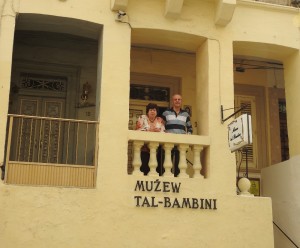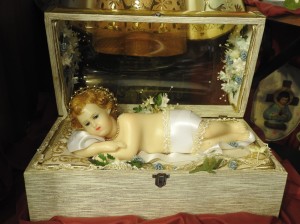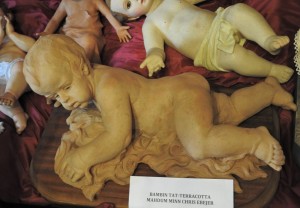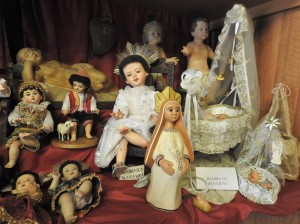-
A Christmas Nursery
Even as a young child, Paul Pace was very fond of baby Jesus statues. Probably because they reminded him of a number of significant familial moments. His grandma gave him a small wax statue of baby Jesus in order to ease down his sorrow after his father George had to leave for a long time to work with the Navy. On another occasion, his father surprised him when he bought him an expensive statue of baby Jesus that he had longed for, after he succeeded to win a lottery. Now, at 69, Paul owns a collection of more than 2000 of such statues which he has lovingly gathered in a museum that he called ‘Il-Mużew tal-Bambini’.
 His wife Mary shares his passion and she is always present to give him a hand in this museum which they have purchased together.
His wife Mary shares his passion and she is always present to give him a hand in this museum which they have purchased together.“It is such a pleasure to see people getting emotional when they visit our museum. Some become very nostalgic as they remember their childhood. Others notice some statue which was similar to the one that their parents had, and they start recalling their memories. A number of visitors get inspired to buy a baby Jesus statue of their own, while some others decide to go home and search for their neglected antique statue which their grandma had left them,” Paul said.
Since its inauguration in 2010, il-Mużew tal-Bambini has become quite renowned both with the local and the foreign public. Although it is available for viewing by appointment throughout the year, most of the visitors attend to this museum during the Christmas season.
“There is always something new to see because we are continually adding to our collection. Even though by now, we have a problem with space, when we find a particular baby Jesus statue which we love, we just can’t help not to own it,” admitted Mary.
Certainly, the museum is a wonder to behold. The provenance of the statues is worldwide, thereby providing a rich overview of the different cultures. Skin colour, facial characteristics, and posture of these statues vary accordingly.
 A delicate looking baby Jesus which was made in Malta, rests in a musical box and moves his eyes and hands. A dark skinned baby Jesus made from wood in Tanzania looks exotic amongst the others. A curly black-haired toddler Jesus, wearing the traditional costume of Perù, sits on a chair and weeps after stepping on a thorn, according to a local legend. A wooden statue from Betlehem shows Jesus as a boy dressed as a king and sitting on an elegant throne. A teenage Jesus from Atocia is also resting on a chair, but this time, he wears the clothes of a pilgrim and carries a rod. An intricately adorned statue of Jesus from Trapani is embellished with pomegranate for good luck.
A delicate looking baby Jesus which was made in Malta, rests in a musical box and moves his eyes and hands. A dark skinned baby Jesus made from wood in Tanzania looks exotic amongst the others. A curly black-haired toddler Jesus, wearing the traditional costume of Perù, sits on a chair and weeps after stepping on a thorn, according to a local legend. A wooden statue from Betlehem shows Jesus as a boy dressed as a king and sitting on an elegant throne. A teenage Jesus from Atocia is also resting on a chair, but this time, he wears the clothes of a pilgrim and carries a rod. An intricately adorned statue of Jesus from Trapani is embellished with pomegranate for good luck.“Our interest in this aspect has led us to travel to countries which are related to the life of Jesus, and from which we knew that we could find such statues. Our visit to the Holy Land was an incredible experience which gave us the opportunity to walk in the same roads where Jesus lived. Moreover, it was an ideal country from where to acquire some beautiful statues for our collection,” remarked Paul.
“When we visited Prague, we bought 42 different baby Jesus statues!” exclaimed Mary.
 They just had to, they explained, as they saw my startled reaction. This was because according to an old tradition, the statue of baby Jesus in Prague is dressed in different coloured clothes each day. Therefore, they were bound to purchase a number of statues which showed Jesus in several dresses. Nevertheless, not all the statues bought ended up in the museum, since some of these were presents for family members and friends.
They just had to, they explained, as they saw my startled reaction. This was because according to an old tradition, the statue of baby Jesus in Prague is dressed in different coloured clothes each day. Therefore, they were bound to purchase a number of statues which showed Jesus in several dresses. Nevertheless, not all the statues bought ended up in the museum, since some of these were presents for family members and friends.“Many of those who visit our museum are curious to know whether we can remember all our statues, which of course, we do. We can also recall all the places from where we have obtained these items. Each statue has an interesting story behind it and we love to share them with whoever’s interested to listen,” Paul said.
I was all ears and I felt simply fascinated when their narrative started to pour in. One of these stories entailed how they managed to buy a statue of baby Jesus which belonged to St. Ġorġ Preca. Another was related to an excellent bargain which Mary made unknowingly, when she bought a statue for her husband for a low price, and then found out that it dated to the 18th century. I loved also the account relating to a particular container made of mica which was produced in Malta by a German prisoner of war during World War II, and was utilized to hold a statue of baby Jesus.
 “We have many antique statues but the oldest one that we know the date of goes back to 1730. The smallest statue is about 15mm long, whereas the largest one has a length of 80cms. The materials of these statues varies widely and include: stone, alabaster, marble, woods of different kinds, wax, ceramic, concrete, lava, straw, plastic, wool, and even bull’s horn,” Mary explained.
“We have many antique statues but the oldest one that we know the date of goes back to 1730. The smallest statue is about 15mm long, whereas the largest one has a length of 80cms. The materials of these statues varies widely and include: stone, alabaster, marble, woods of different kinds, wax, ceramic, concrete, lava, straw, plastic, wool, and even bull’s horn,” Mary explained.Yet the strangest was yet to come…
“One day, we had a statue which lost its synthetic hair and we decided to try to replace it with some hair of one of our daughters. The experiment succeeded and soon, we provided the hair to a number of other statues by trimming some hair from our other daughter and eventually also from that of our nephews,” smiled Paul as he pointed them out proudly.
Each time that I observed the statues, I noticed a different one which I had not seen before. The collection looked literally endless, and yet each statue was unique. Whilst some of the statues showed simple features, mostly due to the artistic fashion of the time, others were quite elaborate and pretty. Yet there were also a number of outstanding characters which stood out from the rest.
 “The main aim of this museum is to share the sweetness of Christmas and the joy which is inherent in each statue of baby Jesus,” revealed the couple.
“The main aim of this museum is to share the sweetness of Christmas and the joy which is inherent in each statue of baby Jesus,” revealed the couple.However, this place offers much more than that since it nurtures love for one’s family, whilst it cherishes an appreciation for diversity. Undoubtedly, this collection is also an invaluable source for those who are interested to study the changes which took place along the years in the production of such precious artworks.
Il-Mużew tal-Bambini which is located at 17, Triq Santa Tereża, Birkirkara, will be open for the public from Sunday, 13th December 2015 to Wednesday, 6th January 2016.
Opening times: Monday to Saturday from 4:30pm – 8:00pm, Sundays and Public Holidays from 9:00am – noon and from 4:30pm – 8:00pm. For more information, one can call 21492111.
(This article was published in CHRISTMAS TIMES Suppliment issued with The Times of Malta dated 8th December 2015)